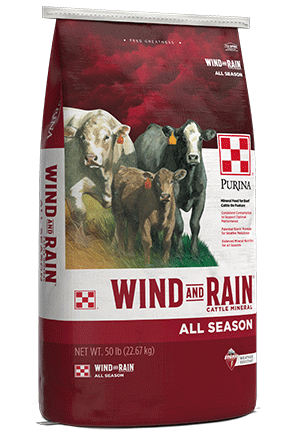
How Can I Get the Most Out of My Cattle Breeding Program?
Management : Cow & Calf
Management : Replacement
Nutrition : Minerals

The reproductive success of a cow is about 10 to 15% heritable. A cow’s environment and how she’s managed makes up the other 85 to 90%. This means you have a huge influence over the success of your cattle breeding program based on the management and nutrition choices you make.
Yet there’s no silver bullet or one-size-fits-all way to optimize a cattle breeding program. To be successful, you have to do many little things right.
Every biological process utilizes minerals and vitamins at the metabolic or cellular level. Specifically, zinc is one of many keys to a cow’s success. It’s critical for muscle and tissue development and supports cows as they return to the ideal condition for breeding. Feeding a mineral high in bioavailable zinc, like Purina® Wind and Rain® ProCycle® mineral or Purina® Wind and Rain® mineral with Zinpro® Availa® 4, is a great way to support your herd leading up to and during the cattle breeding season.1
Ensuring cows have enough energy from protein and fat is also essential. The breeding season is one of the two most challenging and important things we ask a cow to do yearly, the other being calving, which happens just weeks before. Purina® Accuration® Hi-Fat blocks have higher fat content and contain fatty acid profiles that helps cows receive the energy they need for breeding season success.
While every cow has a different threshold to optimize productivity, ideally, a cow should be at BCS 5 at the start of the breeding season. I recommend a BCS 5.5 or 6 for replacement heifers to ensure that the largest portion of the group is likely cycling and capable of becoming pregnant. For bulls to ensure they maintain libido, I like to see them between a BCS 5.5 and 6.
Your veterinarian should conduct breeding soundness exams for mature bulls. Just because a bull was fertile last season doesn’t mean it will be at peak fertility this breeding season. They should also perform overall breeding fitness exams of your replacement heifers.
Vaccinations are another essential piece to maintaining herd health during cattle breeding season. However, their level of importance varies depending on what disease pressure is on your herd. Work with your veterinarian to determine your optimal vaccination strategy for the breeding season.
Does your cattle nutrition program stack up? Find out with a Proof Pays trial.
Yet there’s no silver bullet or one-size-fits-all way to optimize a cattle breeding program. To be successful, you have to do many little things right.
The backbone of success
Every facet of nutrition – including minerals, vitamins, protein and fat – impacts reproduction in some way. Maintaining proper levels of these nutritional values can support a successful cattle breeding program.Every biological process utilizes minerals and vitamins at the metabolic or cellular level. Specifically, zinc is one of many keys to a cow’s success. It’s critical for muscle and tissue development and supports cows as they return to the ideal condition for breeding. Feeding a mineral high in bioavailable zinc, like Purina® Wind and Rain® ProCycle® mineral or Purina® Wind and Rain® mineral with Zinpro® Availa® 4, is a great way to support your herd leading up to and during the cattle breeding season.1
Ensuring cows have enough energy from protein and fat is also essential. The breeding season is one of the two most challenging and important things we ask a cow to do yearly, the other being calving, which happens just weeks before. Purina® Accuration® Hi-Fat blocks have higher fat content and contain fatty acid profiles that helps cows receive the energy they need for breeding season success.
Start strong
At least 60 days, ideally 90 days, before the breeding season, start evaluating your cows’ body condition scores (BCS). The body condition score gives us a general idea of a cow’s overall health, the status of its metabolism and its overall nutritional status. A low body condition score usually inhibits fertility, so maintaining an ideal body condition score is important. Evaluating body condition score early gives you time to make changes that can impact the reproductive system.While every cow has a different threshold to optimize productivity, ideally, a cow should be at BCS 5 at the start of the breeding season. I recommend a BCS 5.5 or 6 for replacement heifers to ensure that the largest portion of the group is likely cycling and capable of becoming pregnant. For bulls to ensure they maintain libido, I like to see them between a BCS 5.5 and 6.
Work with your veterinarian
Besides your nutritionist, your veterinarian is the most important person you should communicate with before and during the cattle breeding season.Your veterinarian should conduct breeding soundness exams for mature bulls. Just because a bull was fertile last season doesn’t mean it will be at peak fertility this breeding season. They should also perform overall breeding fitness exams of your replacement heifers.
Vaccinations are another essential piece to maintaining herd health during cattle breeding season. However, their level of importance varies depending on what disease pressure is on your herd. Work with your veterinarian to determine your optimal vaccination strategy for the breeding season.
The right fit
Everyone has a different genetic base they’re working with and different goals. What works for your neighbor may not work for you. To optimize breeding success for your herd, build a team of core advisors, including your nutritionist and veterinarian, who work together with you to reach your specific cattle breeding goals.Does your cattle nutrition program stack up? Find out with a Proof Pays trial.
1 Availa® 4 is a registered trademark of Zinpro Corp.




